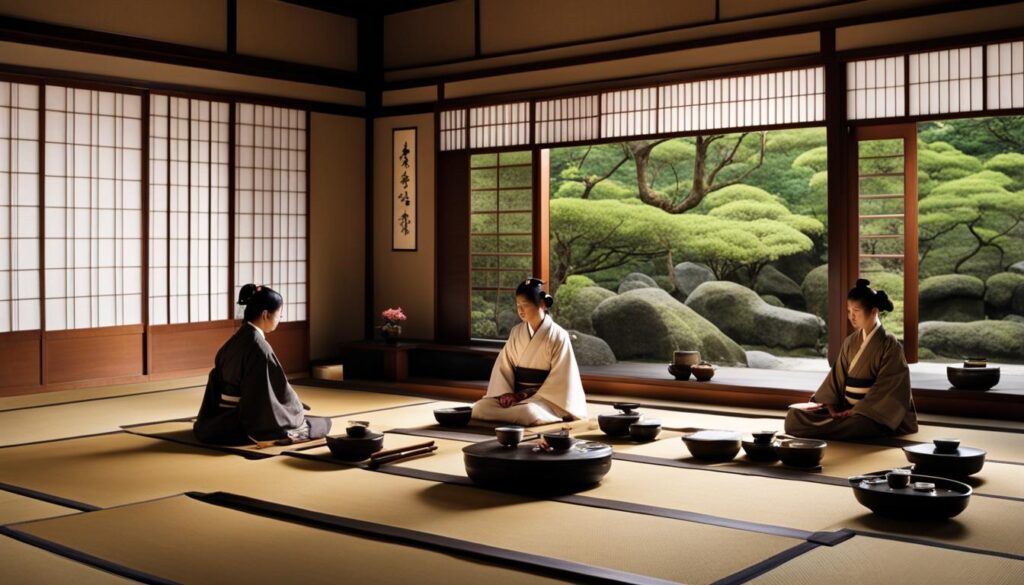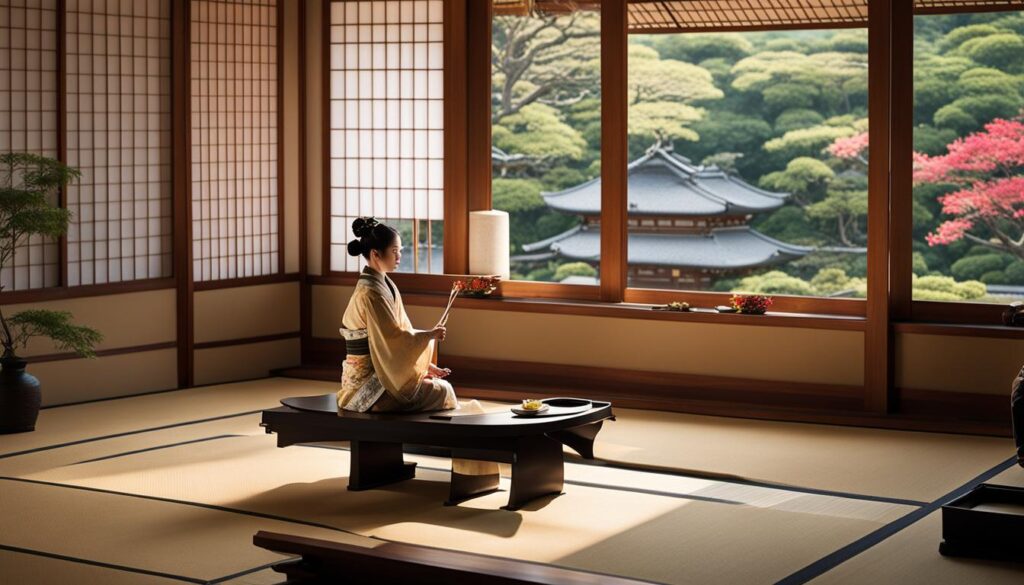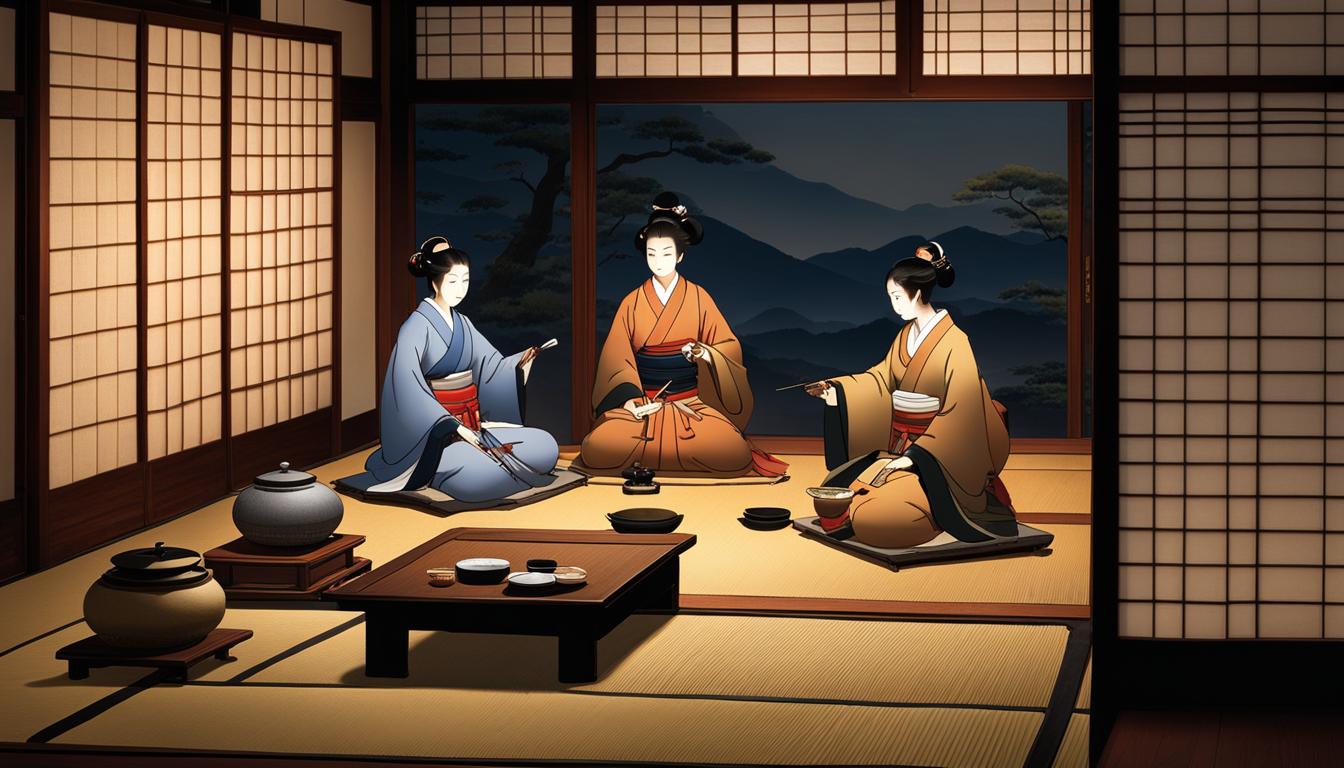Welcome to our exploration of the fascinating world of traditional tea ceremonies! In this article, we will delve into the role of music and poetry in creating a serene and elegant atmosphere during these special events. From ancient Chinese traditions to the spiritual practices of Japan, music and poetry play a vital role in enhancing the sensory and emotional aspects of tea drinking.
Key Takeaways
- Music and poetry are integral to traditional tea ceremonies, promoting purity, harmony, and the appreciation of imperfection.
- In ancient China, tea drinking became associated with poetry, with famous poets like Lu Tong celebrating the sensory experience of tea.
- In Japan, the tea ceremony is closely associated with haiku poetry, capturing moments of nature in short, three-line verses.
- Tea ceremonies incorporate lyrical themes and poetic expression to evoke a contemplative and meditative mood.
- Music accompaniment, including cultural songs and traditional instruments, enhances the overall ambiance of tea ceremonies.
The Historical Significance of Tea in Poetry and Music
Tea, with its origins as a medicinal beverage in China, has a rich history intertwined with poetry and music. During the Tang Dynasty, tea drinking transformed from a simple activity to a pursuit of pleasure and relaxation. Notable poets like Lu Tong penned beautiful verses that celebrated the sensory experience of sipping tea, capturing the essence of its aroma, taste, and spiritual significance.
Music, too, found its place in tea ceremonies, creating an ambiance of tranquility. Traditional Chinese instruments, such as the flute, were often employed to gently infuse the air with melodious melodies, further enhancing the serene atmosphere of the tea ceremony.
“In a poetic voice, Lu Tong described the transformative power of tea: ‘I care not if it is the first cup of tea I am drinking or the last; the feeling of tranquility and subtle pleasure it brings is the same. The first sip moistens my lips and throat, while the second sip banishes all my loneliness. The third sip clears my mind and the fourth sip makes me feel refreshed.'”
Through the use of poetry and music, the act of drinking tea becomes an immersive experience that encompasses the senses and nourishes the soul. The beauty of these artistic expressions resonates with the core principles of tea ceremonies – purity, harmony, and the appreciation of imperfection.
Poetic Delights of the Tang Dynasty
The Tang Dynasty, regarded as a golden age of Chinese poetry, witnessed the emergence of tea as a muse for literary expression. Esteemed poets like Lu Tong, Wang Wei, and Li Bai found inspiration in the simple act of tea drinking, composing verses that celebrated the intimate connection between humans and nature.
| Poet | Poem |
|---|---|
| Lu Tong | “Tea Tale” |
| Wang Wei | “Moonlit Night on the Spring River” |
| Li Bai | “Drinking Alone with the Moon” |
These poems captured the essence of tea, intertwining the sensory experience with themes of nature, tranquility, and the fleeting nature of existence. With their profound insights and elegant verses, the poets of the Tang Dynasty established a rich tradition of tea-inspired poetry that continues to be revered and cherished.
The Japanese Tea Ceremony and Haiku

In Japan, the tea ceremony is known as Chanoyu and is closely associated with the practice of haiku poetry. Haiku poems are short, three-line verses that capture a single moment or observation in nature. The simplicity and brevity of haiku align with the values of tea ceremonies.
Haiku Example:
The old pond,
A frog jumps in:
Plop!
Haiku poems often evoke a sense of tranquility, focusing on nature and the present moment. They complement the serene atmosphere of the tea ceremony and encourage participants to immerse themselves in the beauty of their surroundings.
In addition to poetry, traditional Japanese musical instruments like the koto may accompany the tea ceremony, enhancing the sensory experience and creating a harmonious ambiance. The melodic tones of the koto, a stringed instrument, add a soothing and contemplative element to the ceremony.
The Koto: A Musical Journey
| Fact | Description |
|---|---|
| Origin | The koto originated in ancient China and was introduced to Japan around the 7th century. |
| Structure | The koto is a traditional Japanese zither with thirteen strings stretched over movable bridges. |
| Sound | The koto produces a delicate, resonant sound that can evoke a range of emotions. |
| Repertoire | The koto has a diverse repertoire, with both traditional compositions and modern interpretations. |
| Symbolism | In the tea ceremony, the koto symbolizes elegance, refinement, and the harmony between humans and nature. |
The combination of haiku poetry and the melodic sounds of the koto creates a multisensory experience during the tea ceremony, allowing participants to engage with their surroundings on a deeper level.
Tea Ceremony Lyrical Themes and Poetic Expression
Tea ceremonies are not merely about the act of drinking tea, but also about creating a contemplative and meditative experience. Lyrical themes and poetic expressions are incorporated into tea ceremonies to evoke a sense of tranquility and to encourage participants to connect with the deeper meaning of the ritual. The poetry used during tea ceremonies often explores themes related to nature, tranquility, and the transitory nature of existence.
By incorporating lyrical verses into the ceremony, tea practitioners seek to create a serene and introspective atmosphere. These poetic expressions serve as a form of artistic expression, allowing participants to appreciate the beauty of the moment and reflect on the impermanence of life. The words of ancient poets resonate with the participants, guiding them towards a state of mindfulness and inviting a deeper appreciation of the tea-drinking experience.
As participants listen to the lyrical themes and poetic verses, they are transported to a world of beauty and wonder. The words flow like a gentle melody, intertwining with the aromatic scent of the tea and creating a harmonious ambiance. The combination of tea, music, and poetry elevates the ceremony to a higher level, stimulating the senses and inviting participants to embrace the present moment.
Throughout history, the lyrical themes and poetic expressions used in tea ceremonies have played a crucial role in enhancing the overall experience. From the ancient Chinese tea poems of the Tang Dynasty to the haiku poetry of Japan, the use of poetry in tea ceremonies has evolved and adapted to different cultural contexts. Regardless of the specific lyrical theme chosen, the aim remains the same: to create a sense of harmony, mindfulness, and appreciation for the beauty of the moment.
Musical Accompaniment in Tea Ceremonies
Music plays a significant role in enhancing the ambiance and creating a sense of harmony in tea ceremonies. Cultural songs and traditional music are often performed using various musical instruments, such as the flute, drum, or stringed instruments. The carefully curated selection of music adds cultural significance and a melodic backdrop to the tea ceremony, enhancing the overall sensory experience.
In addition to creating a serene atmosphere, music also helps to evoke emotions and connect participants with the deeper meaning of the tea ceremony. The rhythmic melodies and soothing tones of the instruments transport individuals to a state of tranquility and mindfulness. The combination of music and tea creates a transcendent experience, fostering a deeper appreciation of beauty and interconnectedness with nature.

The Role of Cultural Songs
Cultural songs hold a special place in tea ceremonies, representing the cultural heritage and traditions of the society in which the ceremony takes place. These songs are carefully chosen to align with the themes and values of the ceremony, enhancing the overall experience for participants.
| Song | Instrument | Meaning |
|---|---|---|
| Sakura Sakura | Koto | Symbolizes the beauty of cherry blossoms and the transient nature of life |
| Rokudan no Shirabe | Shamisen | Portrays the elegance and grace of the six poetic arts |
| Soran Bushi | Taiko Drum | Represents the strength and resilience of the Japanese people |
These cultural songs, accompanied by traditional instruments, add a layer of authenticity and cultural richness to the tea ceremony. They evoke a sense of nostalgia and create a deeper connection between participants and their cultural heritage.
“The melodies of the flute and the rhythmic beats of the drum resonate with my soul, transporting me to a world of tranquility and harmony.” – Tea Ceremony Participant
Through the use of musical accompaniment, tea ceremonies become not just a practice of drinking tea, but a multi-sensory experience that engages participants on a spiritual and emotional level. The harmonious blend of music, tea, and cultural traditions ensures that every tea ceremony is a unique and unforgettable event.
Tea Ceremony Poetic Traditions
Poetry has long been intertwined with the art of tea ceremonies, adding an element of artistic expression and contemplation to the experience. Throughout history, tea ceremonies have fostered a rich tradition of poetic expression, allowing participants to connect deeply with the surrounding environment and the profound meaning behind tea drinking. The poetic traditions in tea ceremonies encompass both composed and shared verses that align with the mood and themes of the ceremony.
The act of composing spontaneous poems during a tea ceremony cultivates personal artistic expression and encourages participants to reflect on the present moment. These impromptu verses often explore themes of nature, tranquility, and the transient nature of existence, evoking a contemplative and meditative mood. The deep connection between poetry and the tea ceremony creates a harmonious blend of aesthetic appreciation and introspection.
Participants in tea ceremonies also have the opportunity to share existing verses that resonate with the atmosphere and intent of the gathering. By reciting and discussing these pre-existing poems, the participants deepen their understanding of the shared cultural heritage surrounding tea ceremonies. This exchange of poetic expression adds an emotional depth and connection to the ceremony, enhancing the overall experience for everyone involved.
The Beauty of Spontaneous Poetry
One of the most unique aspects of tea ceremonies is the practice of composing spontaneous poems. This allows participants to tap into their creativity and express their emotions in the present moment. It is a beautiful way to connect with the surroundings and immerse oneself in the serene ambiance of the ceremony.
Sharing Poetic Heritage
Tea ceremonies also provide a platform for sharing existing poems that hold significance to the participants. By reciting and discussing these verses, they create a sense of community and deepen their appreciation for the cultural heritage associated with tea ceremonies.
Aesthetic and Emotional Depth
The inclusion of poetic expression in tea ceremonies adds an aesthetic and emotional depth to the experience. The carefully chosen words and themes resonate with participants, creating a profound connection with the art of tea drinking and the natural world.
Cultural Significance of Tea Ceremony Music and Poetry
Music and poetry hold a significant role in traditional Japanese tea ceremonies, adding depth and cultural richness to the experience. In these ceremonies, music and songs serve as a reflection of the appreciation for beauty, tranquility, and the harmony between humans and nature. The inclusion of music and poetry creates a serene and elegant atmosphere, enhancing the overall ambiance and contributing to a meaningful and memorable tea ceremony.
The Japanese tea ceremony, known as Chanoyu, has deep-rooted connections to the practice of haiku poetry. Haiku poems, with their brevity and simplicity, align perfectly with the values of the tea ceremony. These short, three-line verses capture single moments or observations in nature, allowing participants to connect with the present and find tranquility in the impermanence of life. Alongside haiku, traditional Japanese musical instruments like the koto accompany the tea ceremony, further enhancing the sensory experience and creating a harmonious environment.
Furthermore, tea ceremonies incorporate lyrical themes and poetic expressions as a way to evoke contemplation and meditation. The choice of poetic verses explores topics such as nature, tranquility, and the fleeting nature of existence, deepening the emotional resonance of the tea ceremony. This integration of poetry in the ceremony allows for personal artistic expression and encourages participants to connect with the deeper meaning of tea drinking and the surrounding environment.
Overall, the use of music and poetry in tea ceremonies reflects the cultural values and artistic traditions of Japan. They contribute to the beauty and significance of the ceremony, fostering mindfulness, appreciation of nature’s beauty, and a sense of interconnectedness with the world around us.
| Key Point | Summary |
|---|---|
| Music in Japanese Tea Ceremony | Music plays a vital role in creating a serene and elegant atmosphere during tea ceremonies, enhancing the overall ambiance and sensory experience. |
| Tea Ceremony and Cultural Songs | Cultural songs and traditional music are performed on instruments such as the flute, drum, or stringed instruments, adding cultural significance and a melodic backdrop to the tea ceremony. |
Conclusion
Music and poetry play a vital role in traditional tea ceremonies, adding depth, serenity, and elegance to the experience. Whether it’s the ancient Chinese poetry or the spiritual and artistic practices of Japanese tea ceremonies, music and poetry have the power to enhance the sensory and emotional aspects of tea drinking.
The incorporation of musical accompaniment, lyrical themes, and poetic expression create a harmonious atmosphere that contributes to the cultural significance of tea ceremonies. As the soothing melodies of traditional instruments fill the air, participants are transported to a world of mindfulness and appreciation of beauty.
The combination of music, poetry, and tea creates a transcendent experience that fosters a sense of interconnectedness with nature. It’s a moment where time stands still, and the worries of the outside world fade away. With each sip, we are reminded of the importance of finding inner peace and harmony.
So, the next time you partake in a tea ceremony, take a moment to truly immerse yourself in the music and poetry that surrounds you. Let the melodies and verses transport you to a place of serenity and appreciation. Embrace the cultural significance and artistic traditions that have been passed down through generations. And most importantly, savor every sip with a heart full of gratitude and a mind open to the transformative power of music and poetry.
FAQ
What is the historical significance of tea in poetry and music?
Tea originated as a medicinal beverage in China and eventually became associated with poetry and art. During the Tang Dynasty, poets like Lu Tong wrote famous tea poems that celebrated the sensory experience of drinking tea. Music also played an important role, with traditional Chinese instruments creating a calming ambiance.
How does poetry and music factor into the Japanese tea ceremony?
In Japan, the tea ceremony, known as Chanoyu, is closely associated with the practice of haiku poetry. Haiku poems are short, three-line verses that capture a single moment or observation in nature. Traditional Japanese musical instruments, like the koto, may accompany the tea ceremony, enhancing the sensory experience and creating a harmonious ambiance.
What lyrical themes and poetic expressions are used in tea ceremonies?
Tea ceremonies often incorporate poetic verses that explore topics like nature, tranquility, and the fleeting nature of existence. The choice of poetry adds emotional depth and artistic expression to the ceremony, enhancing the overall experience.
Is music used during tea ceremonies?
Yes, in some tea ceremonies, music is used to enhance the atmosphere and create a sense of harmony. Cultural songs and traditional music may be performed on instruments such as the flute, drum, or stringed instruments. The carefully curated selection of music adds cultural significance and a melodic backdrop to the tea ceremony.
What is the poetic tradition in tea ceremonies?
Tea ceremonies have a rich tradition of poetic expression. Participants may engage in the practice of composing spontaneous poems or sharing existing verses that align with the mood and themes of the ceremony. This allows for personal artistic expression and encourages participants to connect with the deeper meaning of tea drinking and the surrounding environment.
What is the cultural significance of tea ceremony music and poetry?
Music and poetry in tea ceremonies symbolize the appreciation of beauty, tranquility, and the harmony between humans and nature. They reflect the cultural values and artistic traditions of the society in which the tea ceremony is performed, contributing to the overall ambiance and creating a meaningful and memorable experience for participants.





